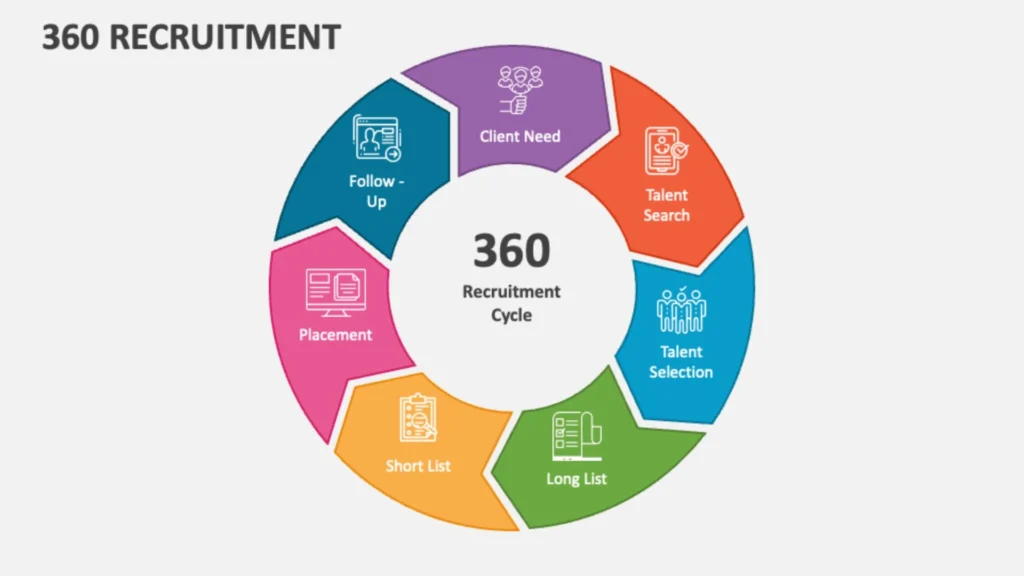360 recruitment, or full-cycle recruitment, is when a single recruiter or recruitment consultant manages the entire hiring process. This can include role briefing, sourcing, screening, interviewing, offer negotiation, and following up once a successful candidate has started.
Rather than splitting the duties between different teams (business development, sourcing, and account management), a single point of contact is responsible for managing the client experience and the candidate experience.
Major Steps in the 360 Recruitment Process
A recruiter effectively navigates their responsibilities through well-defined, orderly, and repeatable stages:
- Discovery of Role & Client: Meeting with hiring managers to gain insight into (the specifics of) the role, culture, team structure, skill deficiencies, and strategic plans. This enables recruiters to provide value in a more consultative manner rather than simply being a CV supplier.
- Sourcing & Attraction of Talent: Writing a targeted job description and engaging various channels for potential candidates, such as job boards, LinkedIn, headhunting, referrals, and internal talent pools.
- Screening and Shortlisting: Looking through CVs and making initial round calls or carrying out video interviews, checking CVs for technical skills, soft skills, and cultural fit in order to make the first shortlist smaller.
- Interview Management: Ensuring the logistical plans for interviews, prepping the clients and candidates, and managing standard feedback on evaluations to prevent hiring bias and miscommunication.
- Offer Negotiations and Acceptance: Coordinate conversations about salary, the notice period on the candidate’s side, the start date, and candidate worries to reduce the probability of an offer drop-off or a last-minute withdrawal.
- Onboarding and Post-Placement Support: Following up after the hire and managing onboarding to ensure a strong start, getting them engaged quickly, and performing well with the ultimate goal of higher retention; frequently, if not always, checking in during the first 30- to 90-day period.
In many organisations, a mature 360 recruitment service is also tightly integrated with HR technology. Applicant tracking systems (ATS), video interviewing facilities, skills assessments, and digital onboarding platforms enable the same recruiter to manage large pipelines without compromising personalisation.
When done well, these tools transform the 360 recruiter into a data-driven partner who can report on time-to-hire, candidate source efficiency, and candidate conversion rates, which will assist business leaders in refining their overall talent strategy.
Benefits of 360 Recruitment for Employers
Using a 360 recruitment model can substantially enhance your hiring speed and quality:
- Single Point of Contact. A recruiter owns the relationship, which decreases hand‑offs, conflicting messages, and delays from sourcing to interviewing to hiring.
- Deep Understanding of Your Business. Since the same person is conversing with leadership, HR, and candidates, they develop a deeper understanding of your culture and what you require – resulting in better matches and fewer mis-hires.
- Reduced Time-to-Fill: The absence of separations or “handover gaps” between teams leads to a quicker decision-making process, which is why positions are usually filled in a shorter time span as compared to segmented models.
- Improved Candidate Experience: Candidates are given a single consistent contact, which thereby establishes trust, keeps them informed, and lessens the incidence of ghosting or dropping out during the process.
- Transitioning to a Strategic partner: Instead of just a Transactional Hiring Vendor: A 360 recruiter ultimately becomes an external HR or TA team member, where they are providing the company with advice on pay grades, available and desirable market trends, and overall role design.
360 Recruitment vs 180 Recruitment
In the case of a 180 recruitment model, responsibilities are typically divided among several consultants, with one focused more on establishing and maintaining relationships with clients and the other focused on sourcing potential candidates. This method may be more appropriate for high-volume transactional hiring situations, but it can also lead to an increase in needed coordination with internal staff.
“360 recruitment”, on the other hand, presents the following advantages:
- All stages are managed under one consultant or individual, enhancing accountability and continuity of engagement.
- Reduces the potential for a “lost-in-translation” scenario for the information exchanged during the processes of sourcing, screening, and extending offers.
- Preferred for relation-driven quality hiring processes with specialisation (for example, within mid-senior or business-critical roles).
When Should Businesses Use 360 Recruitment?
360 recruitment is especially effective when:
- As a startup or small and medium-sized enterprise (SME) that doesn’t have a large internal human resources (HR) team, you require an external partner to handle the entire process.
- You recruit for positions that are specialised, at a senior level or involve direct interaction with the client, where the match of culture and the long-term potential are at least, if not more, as important as the technical skills.
- You care more about quality than volume, particularly in regulated sectors like finance, healthcare, or engineering.
- You are looking for a long-term hiring partner who wants to understand your organisation really well and will help with workforce planning, not just an odd job.
But it is also important to identify where 360 recruitment may fall short. For instance, high-volume, entry-level hiring focused on productivity rather than a deep understanding of the role may benefit from a segment model or 180 approach. In these situations, segmented or 180 approaches still work well.
Many companies end up taking a hybrid approach, deploying 360 recruitment for strategic or hard-to-fill roles while processing a more transactional or segmented model. In doing so, they can keep HR management on a budget while still getting the benefits of the relationship and quality of full-cycle recruitment where it counts (or matters) the most.
How 6 Pence Supports 360 Recruitment
It is simpler for employers in the GCC and across the MENA region to deliver 360 recruitment if they have an experienced partner. 6 Pence merges full-cycle recruitment with local labour law experiences and sector specialisation knowledge to deliver end-to-end hiring support, from role scoping and sourcing to interviews, offers, and onboarding and access to pre-vetted talent pools across white and blue-collar, and specialised sector roles.
At 6Pence, we provide integrated HR and payroll services as needed to ensure all new hires are fully compliant and payrolled accurately from day one. In addition, they offer continuous, post-placement follow-up so as to reduce the incidence of early attrition and thus keep the hiring investment safe.
Companies that partner with 6 Pence and operate under a 360 recruitment model achieve faster hiring processes, obtain higher-quality candidates, and allow their internal teams to focus on other important recruitment activities instead of being burdened with administrative tasks.
Also Read:






